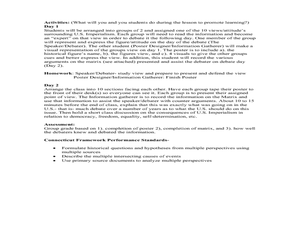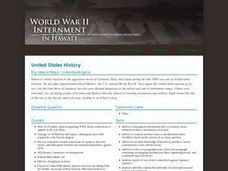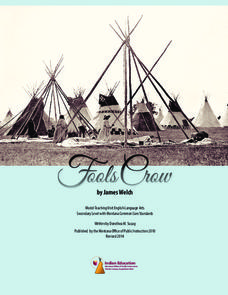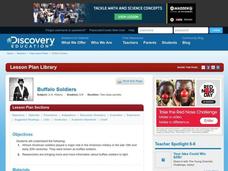National Endowment for the Humanities
The Gulf of Tonkin Resolution and Escalation of the Vietnam War
The Gulf of Tonkin Resolution propelled America's involvement into a bloody conflict—and it was based on a fallacy. Using the resolution and other documents from the Vietnam War, including declassified documents, young historians...
Curated OER
African Americans and the Military of World War II
Fifth graders view a news reel of African Americans in World War II. In this World War II lesson plan, 5th graders discuss the newspaper clippings they get to view and hypothesize about why the African Americans use military news clips....
Curated OER
Japanese-Americans of World War II
High schoolers research the internment of Japanese-Americans during World War II and Roosevelt's Executive Order. They listen to an audio file of the Fifth Amendment before holding a mock trial about the policy of internment of...
Curated OER
Connecting Past and Present...Virtues of Military Veterans
Students explore personalities of those who served as medical personnel in American Civil War, compare qualities those troops possessed to qualities shown by troops currently serving in Armed Forces, and express appreciation to...
Curated OER
Views Concerning U.S. Imperialism after the Spanish-American War
Students research the impact of American Imperialism. In this Spanish-American War lesson plan, students visit the listed Web sites to discover details about the war and its effects. Students use the information they locate to...
Curated OER
American Revolution: Who Am I
In this American Revolution worksheet, students read 5 paragraphs, each giving clues about a famous person in the Revolutionary War. Students use a word bank to find the answer.
Curated OER
A Day in the Life of a Veteran: Oral History
Seventh graders conduct an interview with a veteran of a recent war to provide an account of military conflicts. In this oral history lesson, 7th graders research a recent war and write interview questions for their research. Students...
Curated OER
What Made George Washington a Good Military Leader? Powers and Problems
Students list qualities they believe made George Washington an effective military leader. They discuss difficulties Washington faced as Commander-in-Chief and how he responded to the difficulties he faced as the leader of the Continental...
Curated OER
Uniform Design
Students investigate the military by examining their uniforms. In this design lesson, students analyze the military uniforms from different locations and time periods. Students create new ideas for current military uniforms.
Curated OER
Who Was Contraband?
Learners examine the role of African-Americans in the Civil War. Using primary sources, they analyze the material and formulate their own opinions about the past. They write journal entries to share their opinions on photographs from the...
Curated OER
Southern Perspective on Reconstruction
Students analyze historical perspectives. For this Reconstruction lesson, students compare and contrast the Northern and Southern views on Reconstruction as they analyze letters from Robert E. Lee and read Confederate Military History.
PBS
Women's History: Clara Barton
Students investigate Clara Barton's contributions to society. In this Clara Barton lesson plan, students watch videos, listen to lectures, and conduct research regarding Clara Barton's life and her possible authorship of a Civil War...
Rutgers University
African-Americans in WWII
Using transcripts of interviews of African-Americans who served in WWII, class members work in pairs to understand their experience. Prior to the group work, the teacher provides background on WWII and the African-American experience....
Curated OER
The American Civil War: A Nation Divided (1861-1865)
Intended for use with atlases, this presentation details the causes and effects of the Civil War. It includes historical pictures of battles and discussion points about the technology which emerged during (and for) the war. The final...
Rutgers University
How the Allies Won World War II: Island-hopping in the Central Pacific
Using primary source documents, young historians explore the strategies the US used to defeat Japan during WWII. They also learn about the American military experience, and innovations that changed the style of warfare. Young scholars...
American Battle Monuments Commission
Honoring Service, Achievements, and Sacrifice: A WWI Virtual Field Trip
The largest offensive in United States military history comes alive in a online interactive resource. Young historians explore the Meuse Argonne battlefield and scour the landscape for evidence from the battle. They then use primary...
Curated OER
World War II: Internment in Hawaii
Students examine world history by writing an essay in class. In this World War II lesson, students identify the attack on Pearl Harbor, the response from the U.S and the effect it had on Japanese-Americans. Students define Japanese...
Curated OER
Road To Revolution
Students examine events that occurred and explore the differing sentiments between the British and American colonists in the years leading up to the American Revolution. They view and discuss a video on the events then analyze quotes...
Curated OER
American Veterans: Past and Present
Research groups present an audio report on modern veteran issues in a radio show format.
Smithsonian Institution
Cuban Missile Crisis
The United States—specifically John F. Kennedy—played a large role during the Cuban Missile Crisis. A history resource poses questions that encourage critical thinking as well as in-depth analysis of images from the time period.
Curated OER
James Welch's Fools Crow
Learners explore the history of Montana's Native Americans by reading James Welch's Fools Crow. Set shortly after the Civil War, the novel focuses on a young Blackfoot Indian and his tribe. Over the course of several weeks, class members...
Curated OER
Buffalo Soldiers
Middle schoolers investigate the role of the buffalo soldiers. In this African American history lesson, students research the African American soldiers of the 19th and 20th centuries. Middle schoolers discuss their findings and compose...
Facing History and Ourselves
American Responses to the Armenian Genocide
Young scholars examine World War I war crimes. In this world history instructional activity, students use primary and secondary sources to research and understand the action taken by the United States during the Armenian Genocide. Young...
Curated OER
The Brief American Pageant: The Ordeal of Reconstruction
With a map on the military reconstruction in the post-Civil War South, and an interesting graphic comparing the size of Alaska to the continental United States, this presentation could be a good (albeit short) supplement to a class...

























